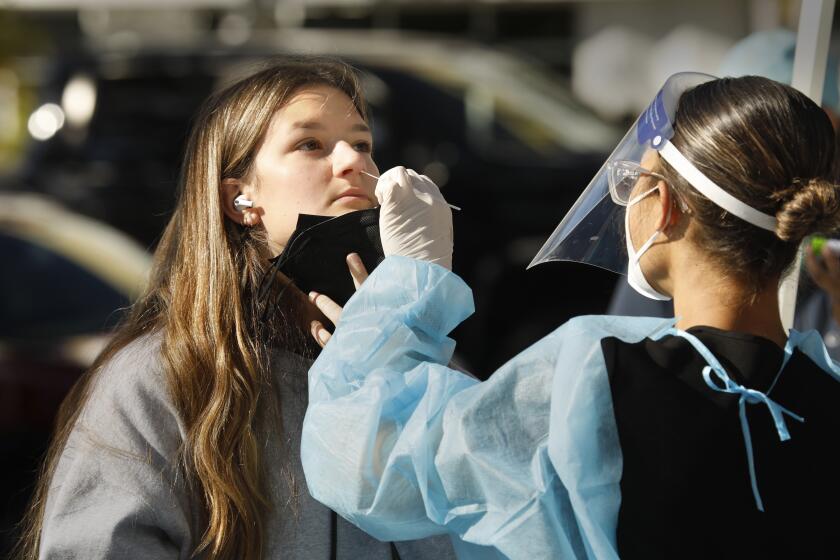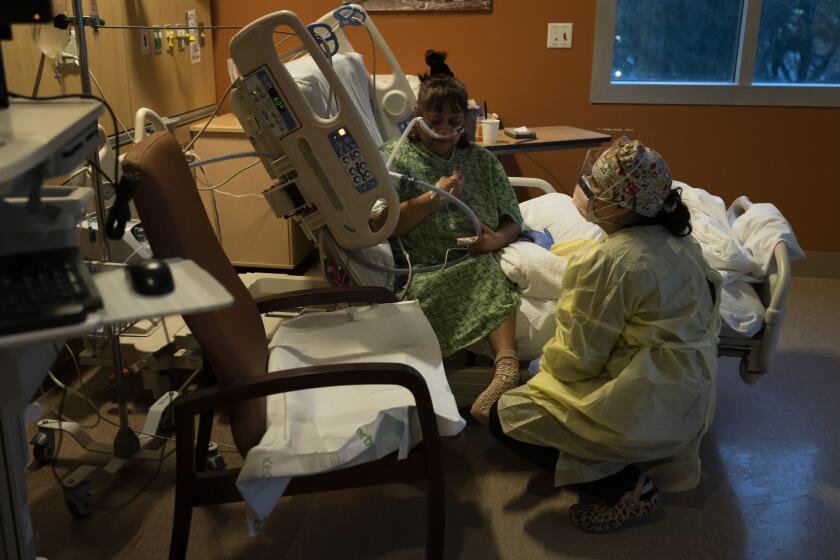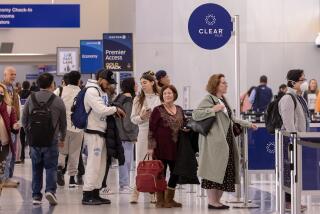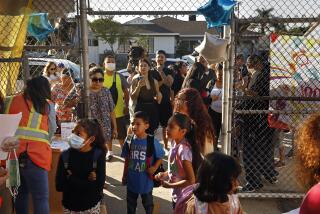Frustrations rise as Gov. Newsom’s vow to screen students for COVID falls short
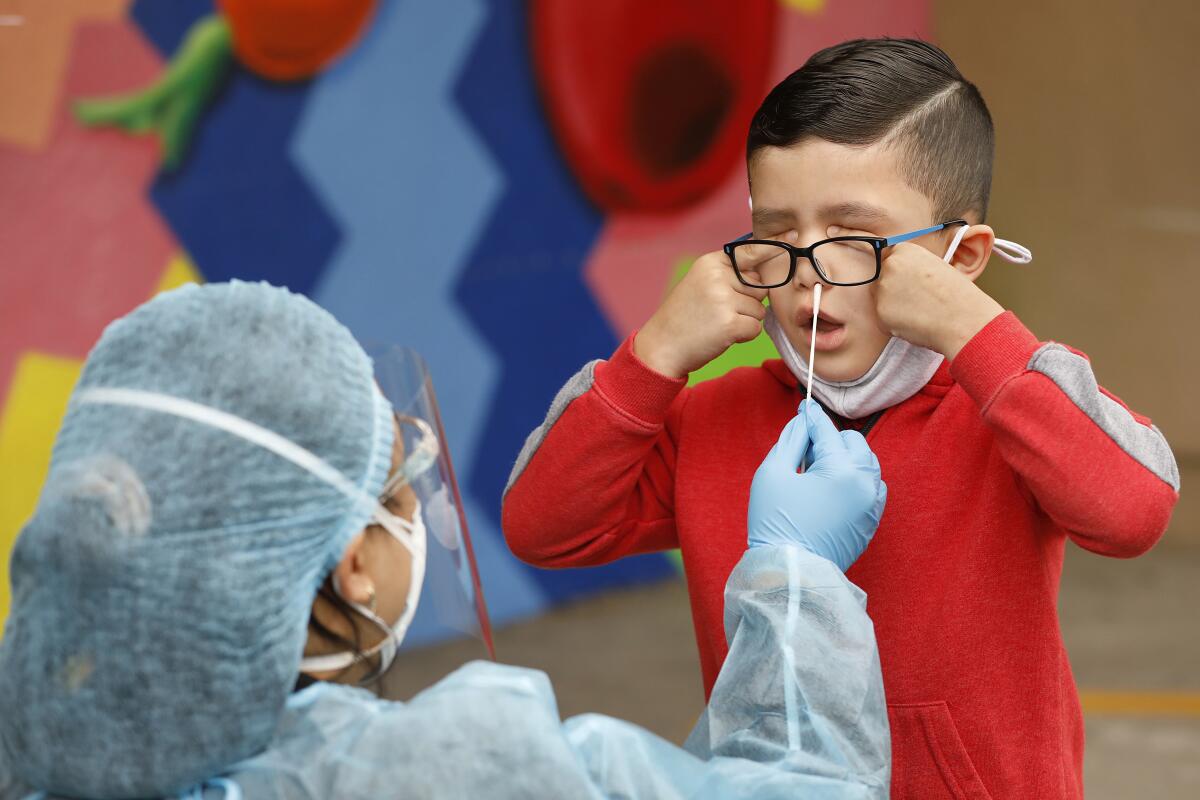
SACRAMENTO — Students in the Burbank Unified School District received a shipment of coronavirus rapid tests from the state Wednesday, but for parents like Nicole Chancey, it was too late.
She sent her 14-year-old daughter to school Monday after the winter break without access to the free at-home tests promised to K-12 parents by Gov. Gavin Newsom, which were delayed by national shortages and winter storms, according to the governor’s office.
After attending classes for three days, Chancey’s daughter finally took a state-provided coronavirus test Thursday morning. It was positive.
“I would never send her to school sick with COVID or anything else. I absolutely feel it is the state, county and school district’s fault for not providing testing for students before school started again after the holiday break,” Chancey said. “Without mandatory testing within our district schools, we have no idea of how many students have COVID-19 and are actively spreading it.”
With the Omicron variant driving a surge in transmission and making testing supplies scarce, schools and parents welcomed Newsom’s announcement on Dec. 22 that the state would provide 6 million tests — enough for every K-12 public school student in California — so that families could screen children before sending them back to school after the holidays.
But what followed was frustration and confusion about where the tests were and whether they would arrive at schools before students returned. How many tests were ultimately made available to families this week is still unclear. As of Friday, 17 counties still had not received any tests, according to data from the governor’s office.
California would spend $2.7 billion on new efforts to respond to COVID-19 cases under a budget proposal Gov. Gavin Newsom will send to lawmakers next week.
For the districts that were able to send students home with tests before the break, the screenings identified hundreds of cases that might have otherwise gone undetected, raising questions about the impact of delayed shipments on school case rates.
The governor’s office pointed to winter storms and supply chain shortages as reasons for the delays, and spokeswoman Erin Mellon called getting millions of tests to counties so far “a massive accomplishment” in the face of “literal rain, sleet and snow.”
“The governor is committed to supporting schools for in-person learning. Testing is an important part of that effort but it’s not the only tool — masks and vaccinations remain key to minimizing the spread of COVID,” Mellon said in an email, adding that the tests were “meant to supplement existing efforts by counties and school districts.”
Of the 6 million tests promised by Newsom, half arrived by Monday, when many school districts returned from break. By Friday, the governor’s office said the state had delivered more tests than originally promised, with more than 7 million shipped and another 2.5 million out for delivery. But that doesn’t mean each of California’s 6 million-plus K-12 students had a test by Friday.
The governor’s office tally accounts for individual tests, counting the two tests that come in each box. If districts did not separate the two tests in each kit, a time-consuming process that those who spoke to The Times said they planned to avoid, the state’s supply is still short a million tests.
The process was prolonged as tests were shipped to county offices of education, which then had to distribute them to school districts, charged with getting them to families.
Data provided by the governor’s office show 40 counties received some or part of their shipment. The state sent 788,000 tests to Los Angeles County, with more on the way, and another 940,000 tests directly to Los Angeles Unified, the second-largest district in the nation.
San Bernardino County had not received any tests as of Friday. The governor’s office said nearly 400,000 tests were en route to San Bernardino.
Los Angeles County continued to report a high number of new coronavirus cases Saturday amid an Omicron-fueled surge.
“We are poised and ready, and we have been,” San Bernardino County Office of Education spokesperson Jenny Owen said. “The test kits are going to offer an additional layer of protection and are beneficial. We are still eagerly awaiting a shipment.”
While not every district in San Bernardino County has returned from winter break, some have, including Chino Valley Unified, which enrolls more than 27,000 students. Roughly 60% of California’s 6 million students returned to school this week, according to data provided by Newsom’s office.
Sacramento City Unified, which resumed Monday, said the state-provided at-home testing kits have so far prevented more than 500 potential “exposures,” calculated from 20,000 preliminary test results reported early this week. The school district received 38,000 test kits from the state before students left for winter break, not enough for the more than 40,000 students enrolled in the district.
“Unfortunately the district did not receive enough kits for all students as we had expected, therefore distribution was focused on ensuring that younger populations ineligible to receive the vaccine were prioritized,” spokesperson Al Goldberg said Wednesday. “The 500 students and staff who have tested positive are now in quarantine to prevent further spread in our schools, which is a huge success for the SCUSD testing and mitigation strategy.”
For counties that received only partial shipments, the California County Superintendents Educational Services Assn. said school officials were left to decide which students get them first.
“It puts county superintendents in a really tough position, to figure out how to distribute these tests to their districts,” spokesperson Kindra Britt said.
San Diego Unified, which also received tests before students left for winter break, reported that at least 1,921 students tested positive and stayed home as of Thursday. The district enrolls more than 100,000 students, and test results are still being collected, a spokesperson said.
The impact of the shipping delays is hard to quantify, said Dr. Jorge Luis Salinas, a hospital epidemiologist at Stanford Health Care.
“Even if they distributed these tests on time before school started, that would have prevented some transmission, but transmission will still occur,” Salinas said. “Many children will be infected in the coming days and weeks and probably more so at home than at school.”
Still, the state’s delivery issues left schools answering pleas from anxious parents and teachers who wanted to know how they could get their hands on the free tests Newsom had vowed to deliver. Some districts, including La Cañada Unified, delayed start times.
While Newsom has not mandated testing, La Cañada Unified joined Los Angeles Unified in requiring tests to return after the holidays. The move comes after La Cañada Unified performed its own school-based testing Monday, which showed a 10% districtwide positivity rate. The effort exhausted the district’s testing supplies, and it was short 5,000 tests as of Tuesday. A spokesperson said Thursday the district had received those tests.
“As soon as we get those, we will have a distribution plan to get those out to families immediately, but I recognize it’s very difficult to get a test if you’re left to your own devices,” Supt. Wendy Sinnette said at an emergency school board meeting Tuesday. “I think it’s important to be transparent: The whole community will be heavily reliant on us getting those 5,000 test kits delivered tomorrow.”
Oakland Unified said testing during the winter break helped identify more than 900 infected students and staff prior to classes resuming Monday. Many of those positive results were from at-home tests distributed by the district. The district sent 41,000 rapid tests home with students and staff prior to or during winter break, with results from half of them uploaded voluntarily into the district’s tracking system. The at-home tests identified 396 students and 64 staffers with positive results as of Sunday, the day before school resumed.
“Although we know the Omicron variant is spreading across the country, we are pleased to see this testing regimen work the way we hoped it would, keeping sick people at home,” Supt. Kyla Johnson-Trammell said in a statement.
Cassondra Curiel, president of the United Educators of San Francisco, said it was a different scenario across the Bay Bridge. The San Francisco Unified School District, which did not receive a state shipment before classes resumed Monday, is operating in the dark, Curiel said.
“So, we have an unknown quantity of individuals with COVID who may be in schools,” Curiel said. “And then you have those who are kept out of school due to anxiety from families or those with symptoms without access to testing to return — there are so many variables in this.”
Curiel, whose union is in negotiations with the 61,000-student district over increased safety precautions and guaranteed sick days for COVID-19, said there was sufficient time for school leadership to prepare testing protocols ahead of the winter break. Curiel said the union wanted the district to follow Los Angeles Unified in requiring a negative test to return to school.
“There was no plan,” Curiel said. “The frustration of the governor not showing up for us — well, he announced that plan Dec. 22. Our students were already home and we know the supply issues.”
San Francisco Unified board member Alison Collins said that two days after school resumed, she received a notice of about 25 coronavirus cases at her child’s school.
“My heart goes out to all the students and families that are now concerned or worried about whether their children have been exposed just in the last two days,” Collins said during a Wednesday news conference with United Educators of San Francisco. “This is not acceptable.”
Last month, Newsom noted the importance of testing students prior to a return to campus. He said the 6 million free tests for schools would “make sure when they go back in person they’re doing so safely, knowing that they have not contracted the disease over the holidays.”
Dr. Mark Ghaly, California’s health and human services secretary, said Wednesday that the tests are not the only way schools can mitigate the spread of COVID-19, but that the state felt it was a good idea to have “a sense, when you can, of what’s happening with students who just spent two weeks doing different things — maybe traveling, maybe spending time with other individuals that aren’t normally part of their circles.”
Roughly 40% of the state’s 1,000-plus school districts — including Los Angeles Unified — do not return to campus until at least Monday, giving the state and local education officials more time to distribute the tests.
“We provided those tests in the hopes that they would add another layer, another blanket of protection, and support to our schools,” Ghaly said.
More to Read
Sign up for Essential California
The most important California stories and recommendations in your inbox every morning.
You may occasionally receive promotional content from the Los Angeles Times.
